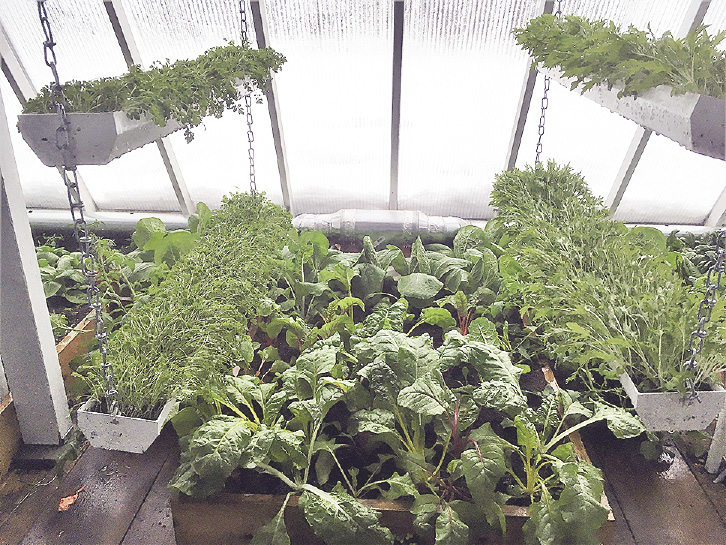In the heart of this past winter, when days were short and the temperatures dropped below freezing, hardy vegetables and herbs were growing in Finland. Initially, the idea seems unfeasible, but the University of Minnesota’s deep winter greenhouse prototype is proving that it’s possible to grow crops in the winter.
One year ago, construction was completed on the greenhouse—one of five across the state. “It has been very productive, much better than I had hoped,” said David Abazs, the AgroEcology Center director. He’s working on the project, which is run by the Organic Consumers Association and the university.
Designed at U of M, this greenhouse is a prototype for researchers to learn about the sustainability of deep winter growing. Here’s how it works: glass angled windows direct warmth from the sun, and four feet of rocks trap the heat. Vents and fans are used to release heat and warm the plants. The goal of building this passive solar greenhouse is to dramatically limit the amount of fossil fuels needed to grow cold hardy crops up north.
On a sunny day during the winter, the greenhouse can be 85 to 100 degrees F., and on darker days it ranges from 48 to 55 degrees F. inside. The lack of light poses one of the biggest challenges for the greenhouse.
Today, one-third of the greenhouse is reserved for research, while the other two-thirds of the crops are for sale. Rows of lush green line the greenhouse, including lettuces, cabbage greens, broccoli, spinach, and radishes, among others. Abazs estimates they’re growing about 50 to 60 varieties.
The herbs and vegetables are being sold at the Finland Cooperative and General Store, and Abazs said they move quickly. “Now we can look at this technology and figure out how can we scale up, and lower the initial costs of construction, and how does it fit into, say, a school cafeteria approach,” he said.
Over the next few years, researchers will compare the metrics of food production between this greenhouse and one in southern Minnesota.
“[We’re] weighing each harvest down to the one hundredth of an ounce,” said Abazs.
If it continues to see success, researchers hope that small scale farmers and gardeners may be able to utilize the design. The initial cost of the greenhouse is currently between $38,000 to $55,000, and it would take years to pay back on crop sales alone. Researchers are also trying to ascertain how it can provide additional value.
“It’s an incredible space. It can be 20 below outside and it can be 75, 80 degrees inside. The space, with the growing plants, the healthy atmosphere of organic production… the green in the stark of winter,” said Abazs, sharing the benefits for gardeners or farmers to consider.
When summer starts, the greenhouse closes for four months for sterilization. At that time, researchers will be able to produce their first report on greenhouse metrics. Those interested in following along with this story can visit: extension.umn.edy/rsdp/statewide/deep-winter-greenhouse.





